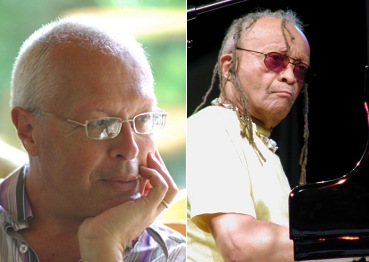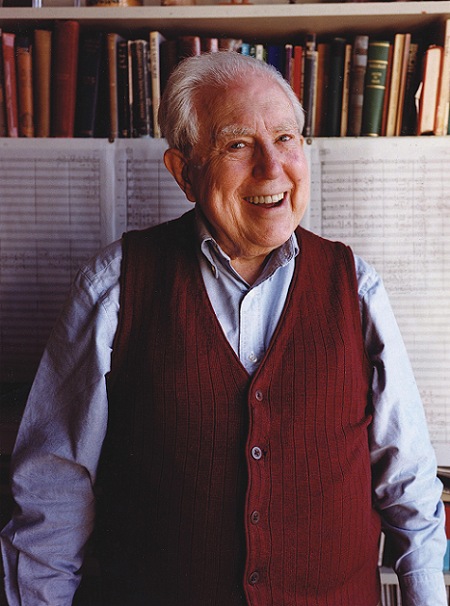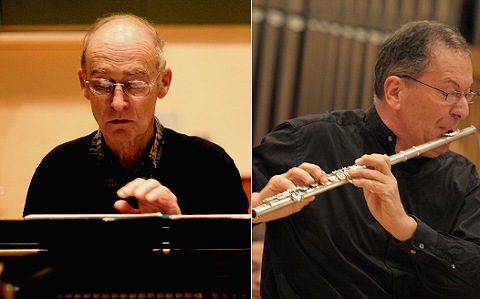 My long-time favorite MP3 download site eMusic has its own little online magazine. One of its features is “Jukebox Jury”, where a musician sits down with the interviewer to chat while listening to and commenting on various tracks played. The latest guest is none other than the N.Y. Philharmonic’s new Music Director, Alan Gilbert. The interview covers a lot of ground in a nicely casual way, with Gilbert listening and then giving his take on everything from his own conducting of Mahler’s 9th Symphony, to tracks featuring Christopher Rouse, Magnus Lindberg, Art Tatum, Uri Caine, John Adams, even The Field and Radiohead.
My long-time favorite MP3 download site eMusic has its own little online magazine. One of its features is “Jukebox Jury”, where a musician sits down with the interviewer to chat while listening to and commenting on various tracks played. The latest guest is none other than the N.Y. Philharmonic’s new Music Director, Alan Gilbert. The interview covers a lot of ground in a nicely casual way, with Gilbert listening and then giving his take on everything from his own conducting of Mahler’s 9th Symphony, to tracks featuring Christopher Rouse, Magnus Lindberg, Art Tatum, Uri Caine, John Adams, even The Field and Radiohead.
…Collide in a good way, that is… The world of “avant” classical and “avant” jazz (I know I know, half of you will cringe at the labels, but it’s as good as we’re going to get here) share so much in common: a long and staid tradition and preconception to fight past and against, to push and trespass beyond; interest in new sounds, new forms, new aesthetics; an intensity of commitment to their vision, even when it might mean a long spell of creating and performing in the shadow of those taking the safe path.
But for all their similarities, there’s also often a kind of fine barrier that keeps many on the classical side from truly “getting” the jazz side, and vice-versa. Differences in approach, language, culture maybe; maybe also a little intimidation with the unknown. (Like my own mystification upon entering a McDonalds — where do you go? How do you order off that board? Do I get my drink, sit down, pick it up where? — when every regular does it all on autopilot.)
To hear the voices cross over and talk about the other is always interesting, and a recent guest post at Jeff Jackson’s and Jeff Golick’s jazz blog Destination:Out seems particularly welcome. In
Some Current Trends in Contemporary Classical Music: An Improviser’s Guide
Steve Lehman — one of the few who fully (and formidably) inhabits both worlds, as both composer and saxophonist — gives “out-jazz” folk an introduction to the likes of Gerard Grisey, Tristan Murail, Michael Finnissy, Helmut Lachenmann and Beat Furrer. The notes on each come from a slight jazz angle, and Steve thoughtfully includes audio of representative works. The comments after the post are also good and worth reading.
A few of the terms and comparisons may be unfamiliar to the avant-classical fan, but really we’re mostly talking, listening, and thinking about the same things. It’s a fairly “eurocentric” list, but you’ve got to start somewhere. And truth told, there are plenty of new-music types on our side, that are still largely unaware of some of these developments, and can only benefit from Steve’s little musical tour.
 Full of food and drink, playing with those presents, a couple days now to relax… How about capping the holiday huddled around the warm, cozy glow of the old ‘puter?
Full of food and drink, playing with those presents, a couple days now to relax… How about capping the holiday huddled around the warm, cozy glow of the old ‘puter?
Because this Sunday the 27th, beginning at 1900 (7pm) EST and running all the way until Monday evening at 1900 (7pm) EST, our new-music radio host-with-the-most Marvin Rosen is having his annual Viva 21st-Century – Women Composers Edition 24-hour broadcast marathon. We’re talking all-women, all-the-time, and all things written only from 2000 ’till today! You’re bound to be enlightened, and possibly even amazed, with much of what you’ll hear. Your geography doesn’t matter either, because wherever you’re at you only need click to WPRB’s live stream and you’re good to go.
So pay a visit; your ears will thank you. And if inclined give a shout to Marvin himself for pushing himself to push this music, and so push you into a greater awareness of all the wonderful stuff being written by women composers in the here and now. (Marvin sez: “Wake up phone calls during this marathon will be welcome“…)
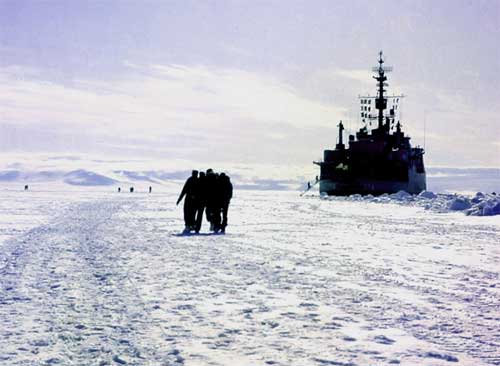 I took this picture at McMurdo Sound, Antarctica around 3 a.m. on December 25, 1966 as some of my shipmates and I made our way back from the McMurdo “Playboy Club” to the U.S.S. Atka, a Navy icebreaker that no longer exists. Given the other military options available to young men on that date, it was not a bad place to be. This rather surreal tableaux of drunken comraderie illustrates, I think, a dirty little secret known to all men and a few women and that is that men–especially hetrosexual men who have worked, lived and played together under difficult circumstances–love each other best.
I took this picture at McMurdo Sound, Antarctica around 3 a.m. on December 25, 1966 as some of my shipmates and I made our way back from the McMurdo “Playboy Club” to the U.S.S. Atka, a Navy icebreaker that no longer exists. Given the other military options available to young men on that date, it was not a bad place to be. This rather surreal tableaux of drunken comraderie illustrates, I think, a dirty little secret known to all men and a few women and that is that men–especially hetrosexual men who have worked, lived and played together under difficult circumstances–love each other best.
I hesitate to repost 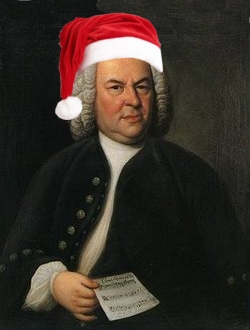 this again, but I find that the links that Google turns up are mostly dead, and some of you seem to like it. So, with best wishes for a happy holdiay season, and without further ado, I give you:
this again, but I find that the links that Google turns up are mostly dead, and some of you seem to like it. So, with best wishes for a happy holdiay season, and without further ado, I give you:
A Visit From J.S. Bach
By Galen H. Brown,
(With apologies to Henry Livingston, Jr.)
‘Twas the night before Christmas, when all through the city
The critics were trying their best to be witty;
They printed their lists of the past year’s best fare,
In hopes that their trendy young readers would care;
But the readers were nestled all snug in their beds,
While vacuous pop idols danced in their heads;
And the Maestro in PJs, and I in my drawers,
Had just settled in to examine some scores,
When out on the lawn, such cacaphonous sound,
I sprang from my desk thinking Zorn was in town. (more…)
It was a time of list-making and so they made a list–the most important new musical works of an otherwise shitty, miserable decade. I’ll begin:
1. La Pasión según San Marcos (2000) Osvaldo Golijov
5. The Little Match Girl Passion David Lang
10. Paradiso Jacob ter Veldhuis
Your turn.
Update 1:
3. September Canons (2002) Ingram Marshall – An incredibly powerful 9/11 remembrance made transcendent by Todd Reynolds’ performance.
 WNYC’s acquisition of New York radio’s stalwart WQXR was a win/lose proposition. Win, in that a major classical station would stay alive; lose in that the new assigned frequency (which can conflict with a powerful Connecticut station on the same frequency) and reduction in broadcast power (from 6,000 watts to only 600 watts) reduces its reach by some millions of potential listeners. Not that it matters much to me, parked on my hiney here in Houston; I and so many others simply go online to hear the station’s stream, anywhere and anytime.
WNYC’s acquisition of New York radio’s stalwart WQXR was a win/lose proposition. Win, in that a major classical station would stay alive; lose in that the new assigned frequency (which can conflict with a powerful Connecticut station on the same frequency) and reduction in broadcast power (from 6,000 watts to only 600 watts) reduces its reach by some millions of potential listeners. Not that it matters much to me, parked on my hiney here in Houston; I and so many others simply go online to hear the station’s stream, anywhere and anytime.
And a further win: Besides the station’s main — and predictably staid — broadcast stream, WQXR also carries another, different internet-only stream called Q2. The music there reverses the current classical-radio standard: i.e., instead of mostly old and safe with a few tiny nuggets of the new, Q2 plays quite a bit new with far fewer chestnuts from classical music’s Ancient Dead Guys Club.
In the past few hours of this morning you could have been listening to Glass, Rautavaara, Ter Veldhuis, Torke, Greenstein, Part, with a just bit of Falla, Palestrina and Chopin sprinkled through for good measure. I know this because they have a great real-time updated playlist page, so you’ll never have to wonder what that work you just heard was. Q2 is just finishing a week-long Steve Reich celebration, and while you’re a bit late for the music you can still read and hear all kinds of interviews about the music from a range of artists, as well as tons from the “old man” himself.
Q2 also has a blog, “Do You Q2“, where you can learn about what’s on any number of musicians minds, and generally stay abreast of upcoming features.
Perfect? No; the new music programmed generally skews closer to the middle of the new road, while I — and I’m sure quite a few others — might like a veer toward the edge more often (or occasionally even off the path altogether!). But still, Q2 should definitely be a daily stop for new-music lovers.
 Musical America is honoring Louis Andriessen as their 2010 Composer of the Year. Seems a fitting tribute in his seventieth birthday year.
Musical America is honoring Louis Andriessen as their 2010 Composer of the Year. Seems a fitting tribute in his seventieth birthday year.
That said, there’s been much activity in the contemporary classical arena in 2009. Who would the Sequenza 21 community like to see getting lauded for their achievements? The comments section is open for nominations.
The S.E.M. Ensemble will open its 40th anniversary season with its annual Christmas concert at Paula Cooper Gallery in New York City on Tuesday, December 15. SEM has performed a holiday concert at the gallery for the last 25 years, and this year’s program will feature two N.Y. premieres by new-music icon Christian Wolff (above left), the first public performance of Petr Kotik‘s (above right) new percussion work performed by TimeTable Percussion, and Lejaren Hiller‘s rarely heard String Quartet no. 5, along with a work by J.S. Bach.
Christian Wolff is also marking his 75th birthday this year, and has put together a kind of celebratory all-Wolff concert at Roulette on Dec 12th. Christian was kind enough to write a bit about his music on both of these concerts:
On December 15, the S.E.M. Ensemble will perform two New York premieres of my work: “Flutist (with percussionists)” and “For John”, as part of their annual concert at Paula Cooper Gallery (NYC). This will be one more in a long line of performances of my music by Petr Kotik and the S.E.M. Ensemble, beginning, I think, in the early 1970s, not long after Petr came to Buffalo – he had already organized the first performance of an early piece of mine in Prague in the 60s. There has been an extraordinary continuity of support. And, with this encouragement, I’ve also written pieces for the ensemble, as well as for the orchestra associated with it (the S.E.M. Orchestra in New York).
“Flutist (with percussionists)” came about when Chris Nappi, longtime percussionist for the SEM ensemble and friend, asked me for a piece – in exchange for music copying he had done for me. He wanted something to play with another percussionist, so the music is for more than one player. Then Petr Kotik, composer, conductor and excellent flutist, had me at his Ostrava (Czech Republic) New Music Days in 2003. I can’t exactly remember, but I think he was looking for some additional music for one of the concerts, so I made solo flute music for him, and then, since Chris was also there, it occurred to me the two pieces could be done simultaneously. Each piece has pauses of free duration, determined in the process of playing by the performers, so that they can be free to space their material in relation to one another, improvisationally. In addition, the flute material consists of a collection of shorter units which can be played in any sequence, as the player decides, and sometimes repeated, so that’s another element in ‘improvising’ the relation of the two pieces.
“For John” was written as part of a collaborative piece titled “For John” in celebration of John Cage at Bard College a few years ago (when the John Cage Archive was relocated at Bard). My contribution was a small set of piano nocturnes and “Material”, music playable by any smaller collection of performers (instrumentation not specified). The others collaborating were David Behrman, John King and Takehisa Kosugi, who played their own work simultaneously with mine, and intermittently we all played from the “Material”.
Then on Saturday, December 12, at 8:30 pm there will be a concert of my music at Roulette. The main item on the program will be the premiere of a new piece “Quintet”, written especially for this occasion.
After an earlier New York concert of my music, which was ok, but not quite ideal, I thought why not try to collect some of my favorite musicians who might be available in the New York area. 2009 is also the year of my 75th birthday, so this might also be a kind of celebration. The musicians are Larry Polansky, composer, long-time friend and colleague in Hanover, New Hampshire (but we both grew up in New York), and fine guitar player; Robyn Schulkowsky, also a longtime friend with whom I’ve done a lot of music, regarded in Europe as the premiere percussionist for new music, but also long associated with people like John Cage and Morton Feldman, and a great improviser; Robert Black, double-bass, also someone with whom I’ve worked over a long time, probably best known as an anchor of the Bang on a Can All-Stars. We also have all been involved in recordings of my music (Robert a CD of all my music involving double-bass, Robyn a solo percussion CD and she and Larry more recently on a recording of 10 “Exercises”). The other player, along with myself (on piano and melodica) will be Joey Baron, drummer, associated for years with John Zorn, but even better known as jazz drummer in his own right. Joey had been hearing my music in the last years and said he liked it, so it occurred to me to ask him to join us, and he agreed – a challenge for both us, me writing for a ‘non-classical/new music’ performer, him playing such music. The element of improvisation, or structural flexibility in my music I hope will provide a bridge.
The rest of the program will consist of earlier pieces, a double-bass solo “Look She Said”, a solo snare drum “Peace March”, and an electric guitar piece “Another Possibility,” written to make up for my losing (it was stolen) the only existing copy of a piece by Morton Feldman, “The possibility of a piece for electric guitar.”
Thanks Christian, Happy (late) Birthday, and have a great show or two! More information for the S.E.M. concert can be had here; for the the Roulette gig click here.
